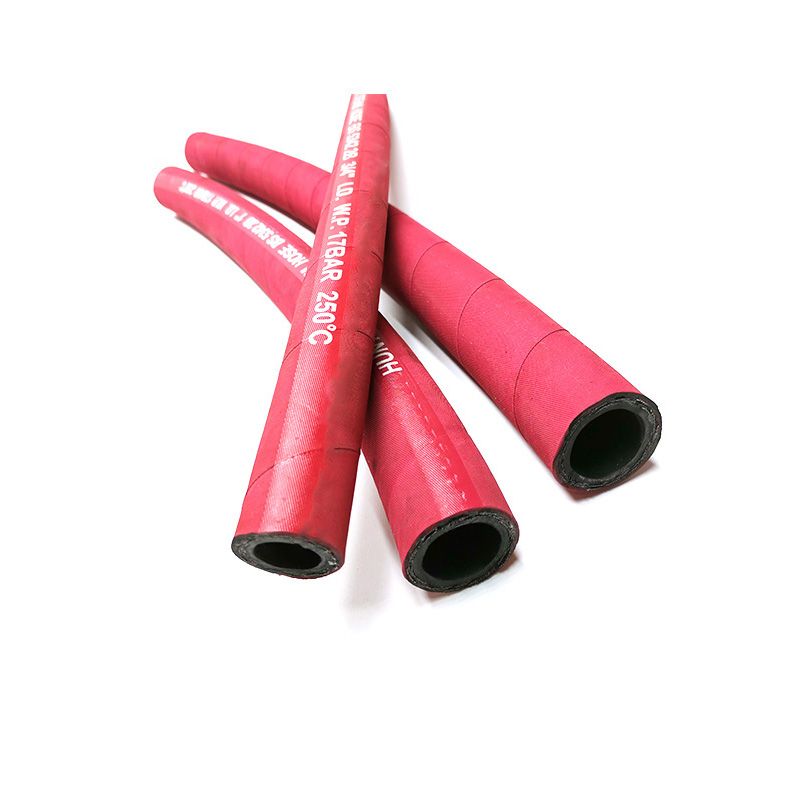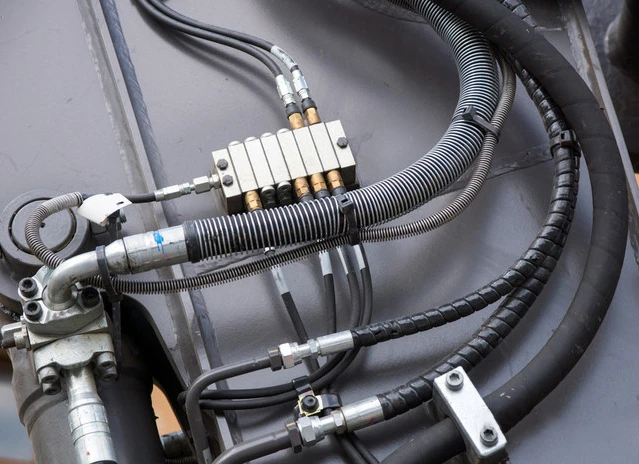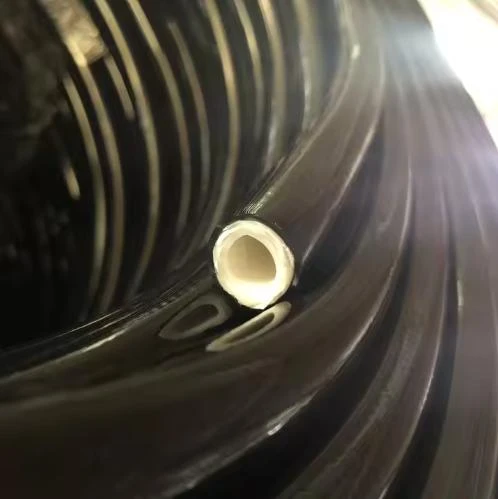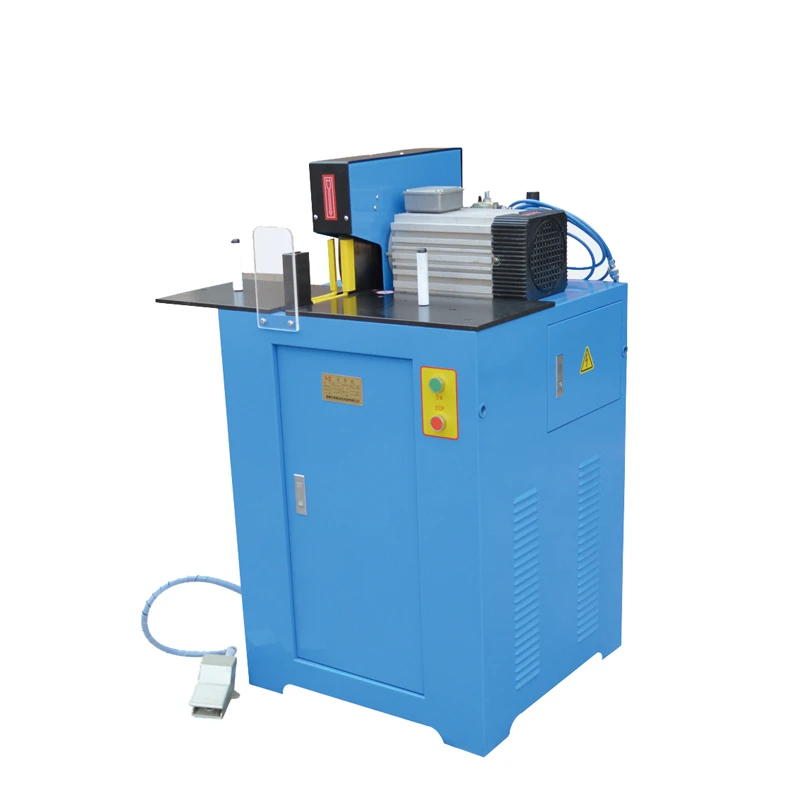Hose ya mvuke
A steam hose is a high-temperature, high-pressure flexible tube designed to convey steam safely and efficiently in industrial and commercial settings. It typically features a heat-resistant inner tube
made from EPDM, silicone, or similar materials, reinforced with textile or steel braiding for added strength, and a durable outer cover that resists abrasion, weathering, and chemicals. Steam hoses are used in a variety of applications, including steam cleaning, sterilization, heating, and humidification. In industries like food processing, they sanitize equipment and surfaces using high-temperature steam. Textile factories use steam hoses in pressing and dyeing operations, while in chemical plants, they facilitate heating and steam transfer for processing and cleaning. Power plants and refineries rely on steam hoses for high-pressure applications, ensuring efficient energy transfer and operational safety. Their ability to withstand extreme temperatures and pressures makes them vital for maintaining cleanliness, efficiency, and safety in environments requiring the controlled use of steam.
What Factors Should You Consider When Selecting a Steam Hose?
Choosing the right steam hose involves evaluating specific factors to ensure it meets the demands of the application. First, consider the operating pressure and temperature range of the system, as the hose must handle high-pressure steam without failure. The material of the inner tube should be compatible with steam and resistant to degradation from prolonged exposure to high temperatures. Reinforcement, such as wire braiding or multiple textile layers, is essential for strength and flexibility, particularly in applications involving movement or bending. The outer cover should provide resistance to abrasion, chemicals, and environmental factors like UV rays and ozone. Length and diameter must match the system requirements, ensuring adequate flow without causing pressure drops. End fittings and connections must be compatible with the hose and provide a secure, leak-free seal. Finally, compliance with safety standards and industry certifications, such as ISO or ASTM, ensures the hose is suitable for use in demanding applications. By carefully considering these factors, you can select a steam hose that delivers reliable and safe performance.
What Materials Are Used to Construct Steam Hoses, And Why Are They Suitable?
Steam hoses are constructed from materials chosen for their ability to withstand high temperatures, pressures, and harsh environments. The inner tube is often made from EPDM (ethylene propylene diene monomer) rubber, which is highly resistant to heat, steam, and oxidation, making it ideal for continuous exposure to high temperatures. Silicone rubber is also used for its flexibility and heat resistance, especially in food-grade applications. Reinforcements such as steel wire braiding or multiple textile layers provide the strength needed to handle high-pressure steam while maintaining flexibility. The outer cover is typically made from weather-resistant synthetic rubber or thermoplastic materials that resist abrasion, chemicals, and environmental factors like ozone and UV exposure. These material choices ensure that steam hoses perform reliably under extreme conditions, providing safety and durability in a wide range of industrial and commercial applications.
Performance Comparison of Steam Hoses and Ordinary Hydraulic Hoses
As a leading steam hose manufacturer, SINOPULSE understands the intricate demands of industrial fluid transfer. While ordinary hydraulic hoses are optimized for standard pressure systems, steam hoses are engineered with specialized features to withstand extreme temperatures and high-pressure steam environments. A detailed comparison of their performance reveals why choosing the right type is crucial for operational efficiency and safety.
Temperature Resistance: The most significant disparity lies in thermal tolerance. SINOPULSE flexible steam hoses, crafted from premium EPDM or silicone rubber, can endure continuous temperatures of up to 250°C and withstand short-term spikes exceeding 300°C. This resilience makes them indispensable in applications such as steam sterilization in food processing plants, where maintaining hygiene standards requires exposure to high-heat steam for extended periods. In contrast, ordinary hydraulic hoses, designed primarily for ambient or mildly heated fluids, have a maximum operating range of -40°C to 93°C. Exposing hydraulic hoses to steam temperatures would rapidly degrade the material, leading to cracks, leaks, and potential system failures.
Pressure and Structural Design: Steam hoses feature a robust construction with multiple layers of braided stainless steel or high-tensile synthetic fibers. This reinforcement not only provides flexibility but also enables them to withstand pressures up to 30 bar (435 PSI), making them ideal for dynamic steam distribution in industrial settings like power plants or textile mills. On the other hand, hydraulic hoses prioritize high-pressure fluid transmission, with some models capable of handling up to 500 bar (7250 PSI). However, their structural design focuses on mechanical strength rather than heat resistance, which means they lack the flexibility and thermal stability required for steam applications.
Material Compatibility: SINOPULSE rubber steam hoses are specifically formulated to resist steam-induced degradation, preventing issues like swelling, cracking, or chemical breakdown caused by prolonged exposure to moisture and high heat. Many of our steam hoses also feature inner liners that comply with strict FDA or NSF standards, ensuring safety in food-grade applications. In contrast, hydraulic hoses are engineered for compatibility with a wide range of hydraulic fluids, including mineral oils, water-glycol mixtures, and synthetic lubricants. While effective for their intended use, these materials lack the specialized anti-aging properties necessary to withstand steam, making them unsuitable for high-temperature steam transfer.
Lifespan and Maintenance: Another key difference lies in longevity and upkeep. Due to their specialized materials and construction, SINOPULSE braided steam hoses offer extended service life even under harsh conditions, reducing the frequency of replacements and associated downtime. Hydraulic hoses, while durable in their own right, require more frequent inspection and maintenance when used in environments outside their designed parameters.
For any application involving steam, choosing SINOPULSE steam hoses guarantees reliable performance, enhanced safety, and cost-effective operation. Reach out to our experts to find the perfect solution for your high-temperature fluid transfer needs.
Key Applications of High-Pressure Steam Hoses: Energy Industry
As a leading steam hose manufacturer, SINOPULSE’s high-pressure steam hoses play a pivotal role in the energy sector, enabling efficient and safe operations across diverse applications. Engineered with robust materials and advanced designs, our flexible steam hoses are trusted solutions for demanding environments where reliability is non-negotiable.
Power Generation: In thermal power plants, SINOPULSE braided steam hoses are integral to transferring high-pressure steam from boilers to turbines. With the ability to withstand temperatures up to 250°C and pressures exceeding 30 bar, these hoses ensure seamless energy conversion, minimizing heat loss and maximizing efficiency. Their flexibility also allows for easy installation around complex piping systems, reducing the risk of kinks or leaks that could disrupt power generation.
Oil and Gas Extraction: During steam flooding operations in oil fields, high-pressure steam is injected into reservoirs to reduce oil viscosity and enhance extraction. SINOPULSE rubber steam hoses, constructed with heat-resistant EPDM and reinforced with stainless steel braids, can endure the harsh conditions of these processes. They maintain integrity under extreme pressures and abrasive environments, facilitating continuous steam delivery and boosting oil recovery rates.
Geothermal Energy: Geothermal power plants rely on steam hoses to transport superheated steam from underground reservoirs to power turbines. Our high-pressure steam hoses, designed to resist chemical corrosion from geothermal fluids, ensure long-term performance in these challenging settings. Their durability and flexibility make them ideal for navigating the rugged terrain often associated with geothermal sites, enabling efficient energy harnessing from natural heat sources.
In the energy industry, where operational downtime translates to significant losses, SINOPULSE’s high-pressure steam hoses offer the reliability, durability, and performance needed to drive critical processes forward. Trust our expertise to meet your most demanding steam transfer requirements.












